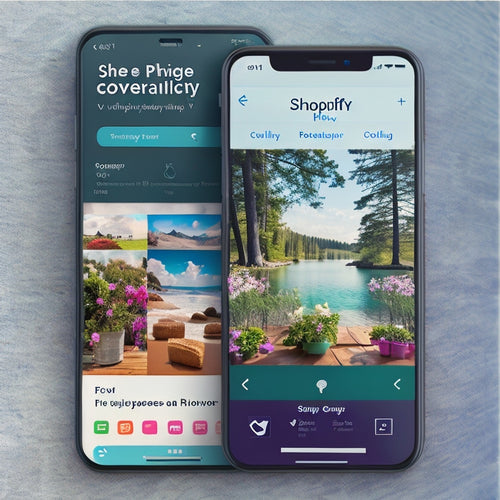
Unlock Proven Course Templates for Online Success
Share
You're one proven course template away from transforming your online business, regardless of your subject matter expertise or teaching experience. Using tested templates, you'll save time and energy on course design, craft a clear narrative, and incorporate interactive elements for engagement. You'll strike a balance between theory and practice, and create an ecommerce course that drives sales. By breaking down courses into manageable chunks, focusing on one key concept per lesson, and incorporating graphic design elements, you'll develop high-quality content that resonates with your target audience. Now, discover the exact strategies to reveal your online success.
Key Takeaways
• Leverage proven course templates to save time and energy on course design, and craft a clear and concise narrative for online success.
• Structure your knowledge into engaging courses that resonate with your target audience and drive sales.
• Break down complex topics into manageable chunks, focusing on one key concept or skill per lesson for easy digestion.
• Incorporate interactive elements, such as gamification and feedback mechanisms, to boost engagement and retention.
• Develop a well-structured course outline with engaging activities and learning objectives to provide a roadmap for students' success.
Proven Templates for Online Success
Leverage tried-and-true course templates that have already generated millions of dollars in revenue to fast-track your online success. By using a proven template, you'll save time and energy on course design, allowing you to focus on creating high-quality content that resonates with your audience.
A well-structured template will guide you in crafting a clear and concise narrative, making it easy for students to follow along and stay engaged.
To maximize student engagement, incorporate interactive elements such as quizzes, discussions, and assignments that encourage participation and feedback. A proven template will show you how to strike the right balance between theory and practice, ensuring that students can apply what they've learned to real-world scenarios.
Unlocking Ecommerce Course Potential
What's holding you back from creating an ecommerce course that truly drives sales and transforms your students' online stores? You've got the expertise, but maybe you're struggling to structure your knowledge into a thorough and engaging course.
Or perhaps you're unsure how to design a course that resonates with your target audience and sets them up for eCommerce growth.
The truth is, creating a high-quality ecommerce course requires more than just throwing together some video lessons and calling it a day. It demands a deliberate and strategic approach to course design.
You need to identify the pain points of your students, craft a clear and concise narrative, and deliver actionable insights that drive real results.
Simplifying Content Creation Process
You can simplify the content creation process by breaking down your ecommerce course into manageable chunks, focusing on one key concept or skill per lesson. This approach helps you create a clear content organization, making it easier to develop and deliver your course.
By doing so, you'll avoid feeling overwhelmed and make sure that your students grasp each concept before moving on to the next. To make your lessons more engaging, incorporate graphic design elements, such as infographics, diagrams, and illustrations, to break up text and enhance visual appeal.
This won't only make your content more attractive but also help students understand complex ideas more easily. Additionally, consider creating a content calendar to plan and schedule your lessons in advance. This will save you time and energy, allowing you to focus on delivering high-quality content that resonates with your audience.
Maximizing Course Engagement Strategies
To captivate your students' attention and encourage active participation, incorporate interactive elements, such as quizzes, discussions, and gamification, into your ecommerce course. These interactive activities won't only keep your students engaged but also help them retain information better.
Here are some strategies to maximize course engagement:
-
Create a community: Encourage students to interact with each other through discussion forums, social media groups, or live sessions. This will help build a sense of belonging and foster collaboration.
-
Make it competitive: Incorporate gamification elements, such as leaderboards, badges, or rewards, to make the learning experience more exciting and fun.
-
Encourage feedback: Ask students for feedback and use it to improve your course content and delivery. This will make them feel valued and invested in the learning process.
- Celebrate milestones: Recognize and celebrate students' progress and achievements to keep them motivated and engaged.
Crafting Compelling Course Outlines
Developing a clear, well-structured course outline is crucial to guiding students through your ecommerce course and helping them achieve their learning objectives. A well-crafted outline ensures that your content is organized, easy to follow, and engaging. It's the backbone of your course, providing a roadmap for both you and your students.
To create an effective course outline, consider the following:
| Module | Engaging Activities | Learning Objectives |
|---|---|---|
| Introduction | Interactive quiz, Icebreaker | Understand course objectives, Establish a community |
| Module 1 | Group discussion, Case study | Identify target audience, Develop marketing strategy |
| Module 2 | Live session, Q&A | Create engaging content, Build brand awareness |
| Module 3 | Gamification, Role-playing | Develop sales funnel, Optimize website |
| Module 4 | Project submission, Feedback | Launch and market product, Analyze results |
Effective Course Launch Preparation
Setting a launch date and building anticipation around your ecommerce course creates a sense of excitement and urgency, ultimately driving student engagement and motivation. To secure a successful launch, you'll want to prepare thoroughly. Start by creating a pre-launch checklist to stay organized and focused. This will help you tackle tasks such as finalizing your course content, testing your platform, and setting up payment processing.
Next, develop audience segmentation strategies to effectively target and engage your ideal students. This might involve creating social media groups, email lists, or even hosting webinars to build buzz around your course.
Here are some key tasks to prioritize in your launch preparation:
-
Finalize your course curriculum and create a content calendar
-
Set up and test your course platform and payment processing
-
Develop a marketing strategy and create promotional materials
- Establish a support system for students, such as a help desk or community forum
Measuring Course Performance Metrics
You've successfully launched your ecommerce course, and now it's time to gauge its performance by tracking key metrics that reveal how students are engaging with your content.
To measure course performance, you need to focus on metrics that matter. Start by tracking progress, such as course completion rates, lesson engagement, and assessment results. This data will help you identify areas where students may be struggling or losing interest.
Next, dive deeper into analyzing data to understand student behavior. Look at metrics like time spent on each lesson, bounce rates, and drop-off points. This information will help you refine your content, making it more engaging and effective.
You can also use data to identify your most successful students and understand what they're doing differently. By analyzing this data, you'll be able to refine your course, improve student outcomes, and increase overall success.
Frequently Asked Questions
How Do I Handle Copyright Issues With Course Templates?
As you navigate the creative jungle, beware of copyright predators! You'll need to understand copyright protection and fair use guidelines to avoid costly lawsuits, ensuring your course templates are safe from infringement claims and your online success is untainted.
Can I Use Course Templates for In-Person Teaching Too?
You can definitely use course templates for in-person teaching, blending them with hybrid teaching methods and classroom integration to create engaging, interactive workshops with hands-on activities that captivate your students.
Are Course Templates Suitable for All Learning Styles?
You'll find course templates suit most learning styles, especially visual learners who thrive on diagrams and charts. Incorporate interactive activities to engage kinesthetic learners, and you'll be catering to diverse needs, ensuring effective learning outcomes.
Can I Customize Course Templates to Fit My Brand?
You can definitely customize course templates to fit your brand, ensuring branding consistency while avoiding legal implications. You'll need to tweak graphic design elements, guaranteeing user engagement that reflects your unique style and authority.
Do Course Templates Work for Non-English Speaking Audiences?
You'll need to overcome language barriers and translation challenges by incorporating cultural adaptation and localization strategies, ensuring your course templates resonate with non-English speaking audiences, and ultimately, drive engagement and results.
Related Posts
-

Is There an Instagram App for Shopify
This article explores the possibility of an Instagram app for Shopify and its potential benefits for marketing purpo...
-

SEO Shopify Apps Empower Merchants to Boost Organic Traffic by Enhancing Their Site's Visibility on Search Engines
This article explores the efficacy of SEO Shopify apps in enabling merchants to enhance their website's visibility o...
-

What Is the Difference Between a Shopify Theme and A Page Builder
This article explores the distinctions between a Shopify theme and a page builder. The objective is to provide a com...


